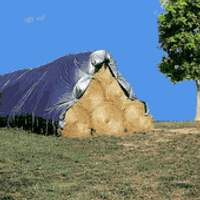Hay Tarps
If you have hay that you need to store and protect, you can keep it in a barn - if you have one, that is. But there is another option that can save you money while also doing a better job of protecting your hay. The heavy-duty hay tarps available from A1 Tarps cost a lot less than building or maintaining a barn but also are a superior way to keep your hay dry.
Left exposed to the elements, hay can develop mold and can also rot, ruining part or all of your hay harvest. This can happen even inside a building such as a barn, especially one with a leaky roof or walls. The longer that hay is stored under bad conditions, the greater the damage will be to the hay and the greater the losses will be for the owner.
The hay tarps available from A1 Tarps will help prevent damage from mold, mildew and moisture. Made of 100 percent polyethylene, these tarps are tough, rugged and weatherproof. Simply wrap them around your bales of hay, whether you have one bay or 10 bales you want to protect, and make sure that you keep the wrapped hay bales in a spot that has good drainage and is not in a low spot subject to pooling. These sturdy hay tarps will protect your hay night and day, rain or shine.
Besides keeping your hay dry, our polyethylene hay tarps are also UV resistant, rot proof and mildew resistant, meaning that they're long lasting. This material doesn't lock the moisture in, further preventing mold, mildew and dry rot. Made of high denier-count polyethylene, these tarps are also tough.
The hay tarps sold by A1 Tarps are available in a variety of sizes, including 25 by 45 feet and 40 by 60 feet. We also can make custom sizes for you, ensuring that you will get exactly the size you need for your own situation and saving you money, because you don't have to pay for an extra amount of tarp that you don't need. Is a barn the most protective option for hay? Some might say yes, simply by looking at the traditional red wooden structure. But when hay is left exposed, even inside a building like a barn, mold and rot may eat away part of the crop. This damage takes away a significant portion of the crop when the hay is stored for several months, and the farmer is cut short in the amount of money he could earn. Does a method that protects hay from moisture and mold exposure exist? Hay tarps are a solution. Made from heavy-duty polyethylene, these tarps are wrapped around several bales of hay to keep out moisture and reduce mold damage. When the formation of covered hay is kept at a drainage or runoff point, the hay stays dry and the amount of damage is reduced. A heavy-duty tarp, in general, is made from polyethylene with a high denier count. The material is treated to be waterproof, UV resistant, rot proof, and mildew resistant. As the material does not lock moisture inside, it prevents mold, mildew, and dry rot from forming underneath. Most lay tarps are long, as they need to wrap around multiple bales of hay. In a triangular formation, these bales are stacked two on the bottom and one on top, for a 2-1 formation. Other possibilities are 2-2-1, 3-2-1, and 4-3-2-1. The tarp, no matter the size of the bales, must wrap fully around, with some excess material left over. As far as size is concerned, all hay tarps are large. Material generally measures between 25 by 45 square feet and 40 by 60 square feet, depending upon the size of the bales. A custom size may need to be purchased in some cases. Placement is another issue for hay tarps. The formation, wrapped in a tarp, should be placed where water will not form. Generally, this is near a drain or in a location with runoff. Read More
Recent Posts
-
When Hiking or Camping with a Tarp, These Are the Tarps to Pack
Hiking or camping with a tarp is always a good idea. But which tarp (or tarps) should you bring with …May 16th 2023 -
Choosing the Right Residential and Commercial Tarps for Your Needs
Whether you need commercial tarps, industrial tarps or tarps for use around your home, there are as …May 16th 2023 -
Heavy-Duty Tarps That Can Handle Tough Jobs
At A1 Tarps, all our tarps are made to be tough, with features like heat-sealed seams and reinforced …May 15th 2023

